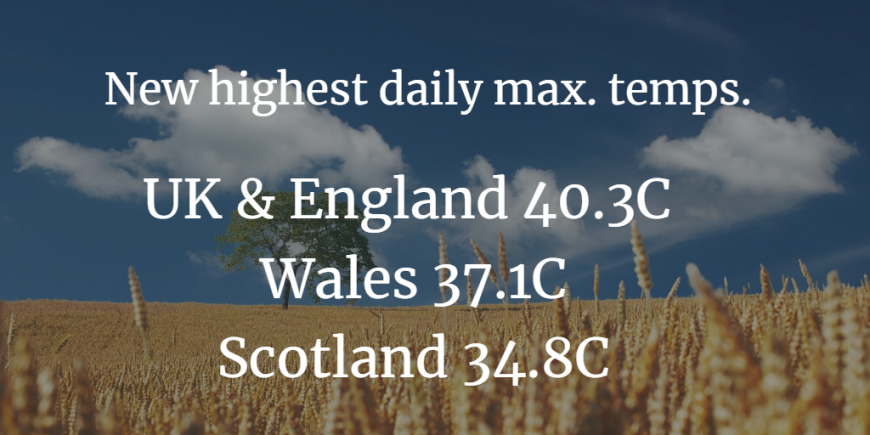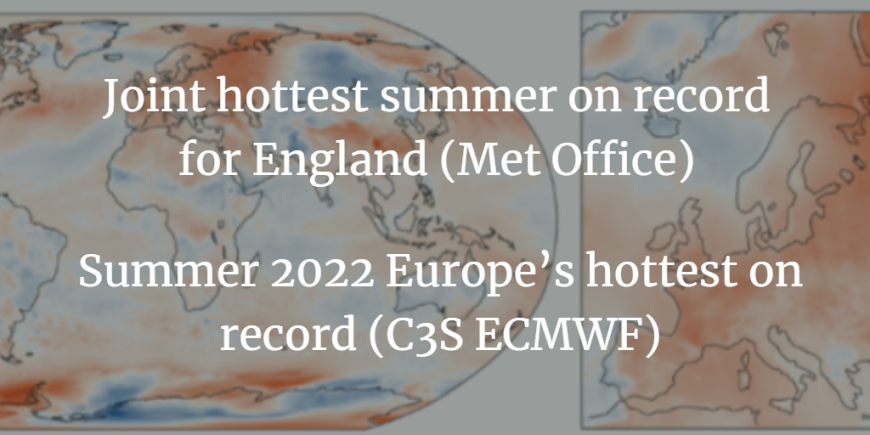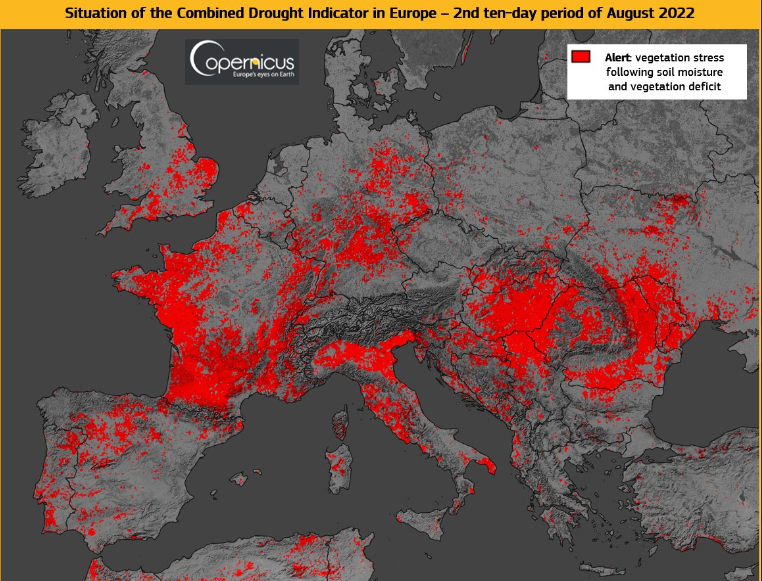
Summer 2022 was certainly memorable. Here in the UK, there were several heatwaves and extreme heat events. The UK's all-time record was smashed with the highest ever day maximum temperature of 40.3C (104.5F) at Coningsby in Lincolnshire. The previous record was 38.7C in 2019 which had beaten 38.5C in 2003. When new UK records do happen, they are usually in small increments, not a leap of 1.4C
The 40.3C has now been confirmed by the Met Office “ following a rigorous process of analysis and quality control” These quality control measures relate to the internationally agreed standards from the WMO, the World Meteorological Organisation, in order to be officially accepted as a new record.

A few of the reported highs this summer did not pass inspection. In Scotland, Floors Castle, a daytime high and Nunraw, an overnight high, have both been discounted. The provisional new UK highest daily minimum temperature is still being checked. So, caution is needed whenever new record temperatures are “observed”. They are provisional and the checking process can take some time.
Anyway, it was very hot and Wales saw a new all-time high of 37.1C at Hawarden Airport, Flintshire on 18th July 2022. The new Scottish record is a high of 34.8C at Charterhall in the Scottish Borders on 19th July.
The Coningsby 40.3C occurred on Tuesday 19th July and 46 stations in England met or exceeded the old record that day. Provisionally seven stations recorded over 40C. Dr Mark McCarthy of the National Climate Information Centre said
“In a climate unaffected by human-induced climate change, it would be virtually impossible for temperatures in the UK to reach 40°C but climate change is already making UK heatwaves more frequent, intense and long-lasting.”
According to the UK Met Office, England had its joint hottest summer when using mean temperatures. This is in a series which runs from 1884 and is still provisional. Some observational data takes ages to come in and then has to undergo the quality control process.
“In this case, a difference between 2018 and 2022 is not a statistically robust difference to be able to declare 2022 as an outright record holder.” Met Office
Currently, 2022 is the UK’s warmest year on record so far, for Jan-Aug and the driest year since 1976.
It was dry and hot, with all that brown or yellow grass. There were hosepipe bans and droughts declared in parts of England and Wales. Scotland saw Water Scarcity notices. The heat warnings included serious health concerns for certain groups and for some people they did just have to sit it out, waiting inside with drawn blinds and rest. Yet this summer wasn’t just about these record-breaking peaks. It was the ongoing persistent heat or warmth with a lack of rainfall.

Four out of five of the warmest summers on record, for England, have occurred since 2003. East Anglia and northeast England saw their hottest summer on record. For the UK overall (not just England) it was provisionally the fourth warmest summer. 2018, 2006, 2003, 2022 and 1976 are all very similar.
Looking at summer rainfall, Suffolk has its 2nd driest summer behind 1921 and Norfolk its 3rd. England saw only 50% of its usual summer rainfall. Southern England saw its driest July on record and there have been many dry months in 2022. The UK and England have seen their driest year so far since 1976 and Wales only managed 36% of its usual August rainfall.
Looking at a wider picture, Europe was warm in August as was the world.
“The average temperature over Europe in 2022 was the highest on record for both August and summer (June – August) by substantial margins of 0.8°C over 2018 for August and 0.4°C over 2021 for summer. “Copernicus

August 2022 was globally 0.3°C warmer than 1991-2020 average and the joint 3rd warmest August on record. For Europe, it was the hottest August on record and also for summer (June-August).
European temperatures were the highest above average in the east of the continent in August, however, temperatures in the south-west were still well above average where they had been high also in June and July. Spain, Portugal and France had seen heatwaves, extreme temperature values and wildfires.
Many parts of Europe saw drought conditions even severe drought as dry weather from autumn and the past winter continued through this year. The Global Drought Observatory (GDO) which is part of the Copernicus Emergency Management Service said “The severe precipitation deficit has affected river discharges widely across Europe. Reduced stored water volume has had severe impacts on the energy sector for both hydropower generation and cooling systems of other power plants. “
Grain, maize, soybeans and sunflowers are all suffering this summer from the harsh weather. The climate impacts are in addition to the supply issues from the war in Ukraine. Even here in the UK, the chat at local flower and vegetable shows has been about how the hot, dry weather followed by damaging heavy rains has hit farmers and growers.
Heavy thundery rain has limited benefits in terms of alleviating drought. There will be some useful, welcome rain but once the ground is hard and dry, any sudden intense rainfall will just run off. It can’t soak into the ground. It can also damage crops themselves physically or cause flash flooding. This is a pattern of climate change. More heatwaves lead to drought and more intense downpours leading to dangerous flooding.

Levels - Watch: rainfall deficit and Warning: soil moisture deficit then Alert: vegetation stress
The GDO also reported “The Rhine basin has been affected by a severely dry winter in the Alps with scarce snow accumulation, followed by a dry spring and summer with below average precipitation and above average temperature. Consequently, the Rhine River discharge has been shrinking, causing multi-sectorial impacts and concerns for the incoming months over central Europe. Critical conditions and warnings have been reported for the Netherlands, with impacts on water distribution systems, dike stability and commercial navigation.”
Summer 2022 saw hot and dry conditions over much of western Europe which looks to continue with warm, dry weather into the autumn period. France (provisionally) saw its hottest September day on record on Sept 12th with temperatures passing 40C. There was also the ‘Derecho’ Storm in mid-August – “a rare weather event, with only a few recorded each year worldwide.”
Another cause for concern is the increase in wildfires and the effect on air quality. This affects humans’ health when airborne and ecosystems as the pollutants settle to earth.
“The interaction between pollution and climate change will impose an additional “climate penalty” for hundreds of millions of people,” according to a new report from the World Meteorological Organization (WMO).
“This is a foretaste of the future because we expect a further increase in the frequency, intensity and duration of heatwaves, which could lead to even worse air quality, a phenomenon known as the “climate penalty,” says WMO Secretary-General Prof. Petteri Taalas.
So, looking back at Summer 2022, there will be some who say ”it was a great summer”, and who enjoyed the dry, sunny and hot conditions. And yet there is a more disturbing theme running through the monthly and seasonal statistics, those ever higher record temperatures when you view the resulting impacts.
More discussion in the Climate Change part of Netweather community forum
Loading recent activity...